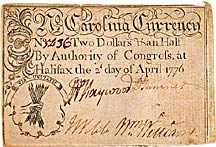|
|

 The
collecting and study of paper money of the United States has been divided
into a number of somewhat chronologically overlapping categories. These
categories are identified in the following listing including short descriptions
of each. Follow the links below for an in-depth discussion and sampling
of the notes in each category. The
collecting and study of paper money of the United States has been divided
into a number of somewhat chronologically overlapping categories. These
categories are identified in the following listing including short descriptions
of each. Follow the links below for an in-depth discussion and sampling
of the notes in each category.
- Colonial Paper Money
Covering the period from 1690 to roughly 1792. The American colonies
were faced with a critical shortage of money from the beginning; the
eastern coastal regions of North America had no major deposits of
gold or silver. This combined with restrictive policies regarding
the export of bullion or coins from England meant that the colonists
had to be creative in order to develop their nascent economy. Tobacco,
nails, beaver pelts adn other commodities were all used at one time
or another as money. In 1690 the Massachussetts Bay Colony approved
the issuance of paper money in order to pay its expenses for an invasion
of Canada during King William's War against the French and Indians.
This paper money constitues the first paper money issued in North
America and the first paper moeny to be issued by a government in
the West.
- Obsolete Bank Notes
 Covering the period from 1792 to 1866. Due to the disastrous experience
with paper money during the Revolutionary War, the writers of the
new Constitution decided to prevent the individual states from issuing
paper money at all and not to issue Federal government paper currency
on a regular basis. However, the critical lack of coined money in
silver or gold made some sort of paper currency absolutely necessary.
Thus banks chartered by the individual States, corporations, and even
individuals began to issue paper money, now known as obsolete bank
notes. This series offers a huge variety of images reflecting the
changing self-image of Americans during this critical period of National
development and expansion. Included in this section is the currency
issued by the Confederate States of America during the Civil War.
Covering the period from 1792 to 1866. Due to the disastrous experience
with paper money during the Revolutionary War, the writers of the
new Constitution decided to prevent the individual states from issuing
paper money at all and not to issue Federal government paper currency
on a regular basis. However, the critical lack of coined money in
silver or gold made some sort of paper currency absolutely necessary.
Thus banks chartered by the individual States, corporations, and even
individuals began to issue paper money, now known as obsolete bank
notes. This series offers a huge variety of images reflecting the
changing self-image of Americans during this critical period of National
development and expansion. Included in this section is the currency
issued by the Confederate States of America during the Civil War.
- National Bank Notes
 Covering
the period from 1863 to 1929. The crisis of the Civil War forced the
Federal government to reevaluate its monetary policies - the huge
expenses of the war made it necessary for the government to issue
paper money and bonds in huge amounts. The old haphazard system of
paper money was drastically revised in order to create a reliable
further source of funds to support the war effort. The National Bank
system created a federally supported organization for banks that provided
insurance for deposits as well as for a standardized design for bank
notes (except the location and name of the banks). Banks could choose
not to join the system but faced substantial tax penalties - by 1866
the last of the independent banks ceased to issue paper money, thus
ending the Obsolete Paper Money era. Covering
the period from 1863 to 1929. The crisis of the Civil War forced the
Federal government to reevaluate its monetary policies - the huge
expenses of the war made it necessary for the government to issue
paper money and bonds in huge amounts. The old haphazard system of
paper money was drastically revised in order to create a reliable
further source of funds to support the war effort. The National Bank
system created a federally supported organization for banks that provided
insurance for deposits as well as for a standardized design for bank
notes (except the location and name of the banks). Banks could choose
not to join the system but faced substantial tax penalties - by 1866
the last of the independent banks ceased to issue paper money, thus
ending the Obsolete Paper Money era.
|






